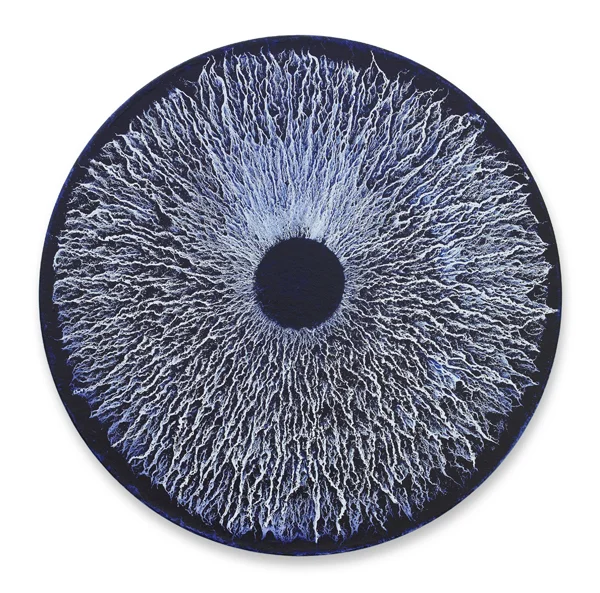Seth Pick
Works
Biography
Bibliography
Previous Shows
Seth Pick – Velvet breath (2017)
Seth Pick – Humiliations (2015)
Seth Pick – Biophilia (2014)
DO NOT DISTURB, invited by Elmgreen & Dragset (2014 Oslo)
Seth Pick
Velvet breath
Exhibition duration: January 27 – February, 2017
On entering Seth Pick’s studio, what strikes one most is the strong sense of materiality. In a state reminiscent of Locke’s prime sensations, sight and smell are activated in a mode of pre-cognitive impression as the pungent smell of paint and white primer announce themselves to the mind while the eye is captured by the spectrum of Goethe’s color wheel with dark, primal colors bleeding into one another in preparatory strokes on the gray concrete wall.
I mention the materiality of the place, because it is the material aspect of this work that distinguishes it from much contemporary art, which often seems in a rush to leave its materiality behind in search of some distinct concept or ironic critique. Instead, this work is shot through with an awareness that it is out of the contingent and fragile components of color and texture that the meaning of these artworks are produced. To say this, however, is insufficient, as the work uses this awareness of its own material aspects, to move well beyond those components. Instead, these works dwell in a space that invites the viewer to reflect on the work philosophically. It does so not only in its unique play with color, but by presenting images and combinations that lead the viewer unawares back to origins: to contemplate ontological depths, exploring the emergence of life out of matter, the choate and meaningful against a background of infinite space.
The “Miosis” series exemplify this point precisely. In these, the mind cannot help but view the black circle as both a pupil in the center of the organ of sight, and as a void. A black hole in the middle of cosmic space whose individual galaxies and systems are lit up by this root-like structure in a vast and almost impersonal manner. By juxtaposing the organic and the inorganic, the eye and the cosmos, the work plays with our capacity for associating ideas. Unable to settle on any specific way of explaining the relationship between these jarringly harmonious elements, the understanding enters into a free play, scanning between the material structure while striving to locate some concept, interpretation, or message, which would unify content and form. Yet despite the conceptual uncertainty at the heart of the work, the mind continues to circle back to a central theme, namely, the problem of the origin of life itself. By taking as its nodal point the very ambiguity of the relationship between consciousness and matter, the question of how life emerges out of nothingness becomes pressing. The work engages the viewer in this question, forcing one to ask how it is possible for the raw matter of the universe to come together in such a way as to create an organ of sight and a creature capable of questioning itself and its own capacity to experience meaning.
To say that this work is refreshing exactly because it brings art back to its most basic elements, is not to say that it lacks either irony or critical capacity. It is only that this work does so by highlighting the strangeness of the materiality of high capitalist society. “Velvet Breath” is a striking example of such a critique. By taking the sterile hospital glove out of its network of circulation and drawing attention to its sheer materiality with one drip off its finger-tip, this piece de-naturalizes the object by bringing out its material fabrication. This is a natural looking object only because it is meant to cover something organic, protect nature from nature through sterilization techniques only possible in a capitalist-scientific world in which nature is reduced to mere mechanism. The isolation draws out this strangeness, depicting how dangerous this unnatural material can be when the viewer cannot tell whether the element coming off the glove is water or ethanol, the bringer of life or the bringer of death.
Yet even in its critique, the work circles back to the question of meaning: how it arises out of the chaos of the universe and how it threatens to cede back into it though the abuses of human society and our continued alienation from nature. Despite this threat and the ever present sense within these works that something is deeply off track with our current capitalist organization, the jarring harmony of color on the canvas successfully ignites in us the Aristotelian wonder that there is something rather than nothing and that life constructs meaning out of lifeless parts of the universe.
This cosmic story is depicted in the piece “Data as an agent of form”. As if arising out of a void, we see strands of green and blue coming together at the top and bottom to create a diamond like shape somewhat conspicuous in its subtle similarity to the double helix structure of DNA. It is precisely at this point that the work of art transforms the merely mechanical origin of organic life through the play of prime colors, hinting at the mystery of consciousness generated and yet manipulable through genetic coding. Leaning in one notices that these strands consist in intricate ribbons interweaving with one another in an infinite number of ways. In following them, one finds that it is almost impossible not to imagine some story, a story made possible only through the inexplicable appearance of consciousness from dead matter, fine-tuned by random evolutionary mutations.
Stephen Klemm is a Ph.D. Candidate in German Studies at Cornell University
For further information please contact Maike Fries at Gerhardsen Gerner, Berlin: T: +49-30-69 51 83 41,
office@gerhardsengerner.com or visit our website at http://www.gerhardsengerner.com




















